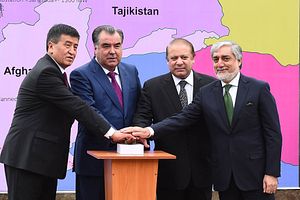Slowly, slowly, the Central Asia South Asia Electricity Transmission and Trade Project (CASA-1000) is making progress. Or, put in other terms, the project is soon approaching a point at which physical infrastructure needs to start going up.
This week, Tajikistan’s Ministry of Energy and Water Resources said, “the implementation of the physical part of the CASA-1000 Project will begin in all countries participating in the Project during this year.”
In Tajikistan, a 1300 MW converter station will be built in Sangtuda but a company has not been selected yet. Asia Plus reported that a ministry source said bids would be opened in March.
In December, Afghanistan’s National Electric Power Company, Da Afghanistan Breshna Sherkat (DABS), awarded three contracts worth a total of $235.16 million to two Indian companies to construct transmission lines from the Tajik border to the Pakistani border, crossing through 23 districts in seven provinces (Kunduz, Baghlan, Panjsher, Kapisa, Kabul, Laghman and Nangarhar).
Kalpa-Taru Power Transmission Limited (KPTL) was awarded one of the contracts worth $76.9 million and KEC International (KEC) signed two contracts worth $85.43 million and $72.83 million. Between the two, more than 500 kilometers of 500 kV HVDC transmission lines will be built across Afghanistan in order to bring electricity from Tajikistan and Kyrgyzstan through Afghanistan to Pakistan.
The World Bank — which is funding a bulk of the CASA-1000 project — seemed optimistic in its latest implementation status and results report, published in late December.
“The implementation of the project is progressing well and gained up sustainable speed over the past several months. The participating countries have completed all the main project agreements and procurement for the major infrastructure packages is in the final stages. The contracts for the construction of the HVDC transmission line in Afganistan (sic) had been awarded and signed in Kabul on December 11, 2017,” the report stated.
The previous report, published in June 2017, stated that implementation was progressing “albeit with delays.”
“Since construction is yet to start, the project is in early stage for reporting results. The participating countries are making efforts to expedite implementation,” the report stated.
CASA-1000 has been an idea for some time, and a project officially since 2015. But as the World Bank’s own documents show, progress has been slow. The latest implementation report includes a list of loans, credits and trust funds supporting the overall project and their disbursement status. So far, only two trust funds (TF) have been disbursed at all — a $500,000 grant for technical assistance to Tajikistan to “facilitate the preparation of the CASA 1000 Project” and $650,000 to Kyrgyzstan for a similar purpose. None of the other loans or grants are effective as of the December report, through most were signed back in 2015.
The rest of the World Bank loans, as listed, total just under $530 million — a significant portion, but less than half the estimated $1.2 billion the whole project will cost. (Asia Plus reports the project cost estimate as $1.7 billion and the CASA-1000 project factsheet, from 2011 but still the reference point on the project’s website, pegs the total just under $1 billion.) The Islamic Development Bank (IDB) and the European Bank for Reconstruction and Development (EBRD) are both funding portions of the project as well.
With the awarding of the Afghan contracts, it can be expected that by the next status report some of those grants will have become active and disbursements begun. The CASA-1000 project has reach the point at which actual structures need to be built for the parties to even half reasonably claim progress. Keep in mind, back in May 2016 Tajikistan hosted an inauguration event for the project — really just a photo op for Tajik President Emomali Rahmon, then-Pakistan Prime Minister Nawaz Sharif, then-Kyrgyz Prime Minister (now president) Sooronbay Jeenbekov, and Afghan Chief Executive Abdullah Abdullah.
At the time, Dawn reported the completion date as 2018. Well, that’s clearly not happening. The World Bank pegs the project’s completion date as June 2020.
But take a peek again at the list of Afghan provinces through which the CASA-1000 projects’ infrastructure must pass: Kunduz, Baghlan, Panjsher, Kapisa, Kabul, Laghman and Nangarhar. As security all over Afghanistan, but particularly in the north and east, falters, security remains CASA-1000’s biggest hurdle. It’s a hurdle that needs to be vaulted for the project to succeed, and the involved parties need it to succeed.































